Gardening Tasks To Do in August
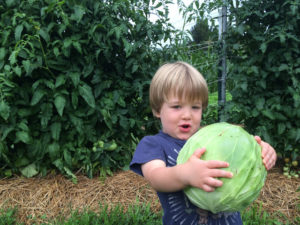 Garden-fresh food on every plate!
Garden-fresh food on every plate!
Here’s the goal: Every family has access to space for a garden in their yard, balcony, or neighborhood and can grow and eat fresh, healthy food.
Wouldn’t that be AWESOME?
One seed, one veggie, one child at a time—we’d all be helping solve complex issues like childhood obesity, social injustice, hunger, and climate change. It’s a lofty goal.
But in harvest season, it feels possible!
August’s garden bounty is upon us with corn, zucchini, and tomatoes. Here are the garden tasks we’re working on this month.
(Pssst…if you’re not feeling the abundance this year, don’t feel bad. I’ve been there…check out #4 below for fresh start ideas.)
Who Is This For?
Our garden checklist is for gardeners interested in growing food and healthy ecosystems. We use organic methods, get the whole family involved, and look for ways to mimic nature using permaculture ideas.
We live in the Northern Hemisphere in USDA Zone 7. These recommendations can be applied to many gardens in Zone 6-8. (Not sure what your zone is? Find your USDA zone here. Not in the U.S.? This pdf comparing international zone systems may help.)
Quick 4 for Busy Gardeners
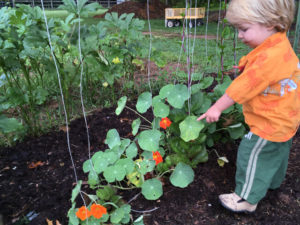
Malba spinach and nasturiums in one of our nicely mulched areas. (Note the okra + weeds in the background…more work to do!)
If you have really limited time for gardening (and reading!), I recommend you focus on these four areas this month:
- Weed…
The weeds get ahead of me this time of year. What about you? Pulling/chopping annuals now—before they set seed—is a good way to get ahead on future weeding. Keep at it! I start with the aggressive, prickly, and itchy ones first. I leave the edible ones for last, so I often end up letting those go to seed. If I could shift the weed population in my garden to mostly edibles, would they even count as weeds? 🙂 - …and Mulch.
I try to do weeding and mulching together. Mulch conserves moisture, cools soil, and inhibits weeds. When I have time, I cut or stomp down weeds, lay down newspaper to block regrowth, and add a thick 4-8″ layer of mulch around (but not touching) the plants. The beds where I’ve done this look great right now! When time is short, I just chop and drop the weeds, but I do see more regrowth without the extra layers on top. If you need mulch, look for a source of grass clippings, compost, dried leaves or pine needles or non-sprayed* straw (*Beware of persistent herbicides sometimes used on conventional straw.) - Enjoy the bounty in your yard and your community.
Challenge yourself to eat fresh veggies each day and try out simple recipes with your family. If one of your crops didn’t make it, visit the local farmer’s market to find someone who had more success. Check out local gardens and farms to get ideas for future plantings and celebrate the harvest season. - Plant for fall. Pull out your “cool crop” seed packets (lettuces, broccoli, kale, collards, carrots, radishes, etc.) and plant a fall garden. I have more success with summertime seeding if I do one of two things: (1) plant just before a stretch of rainy days or (2) plant in trays that I can keep close to the house for closer attention while the seeds are germinating.
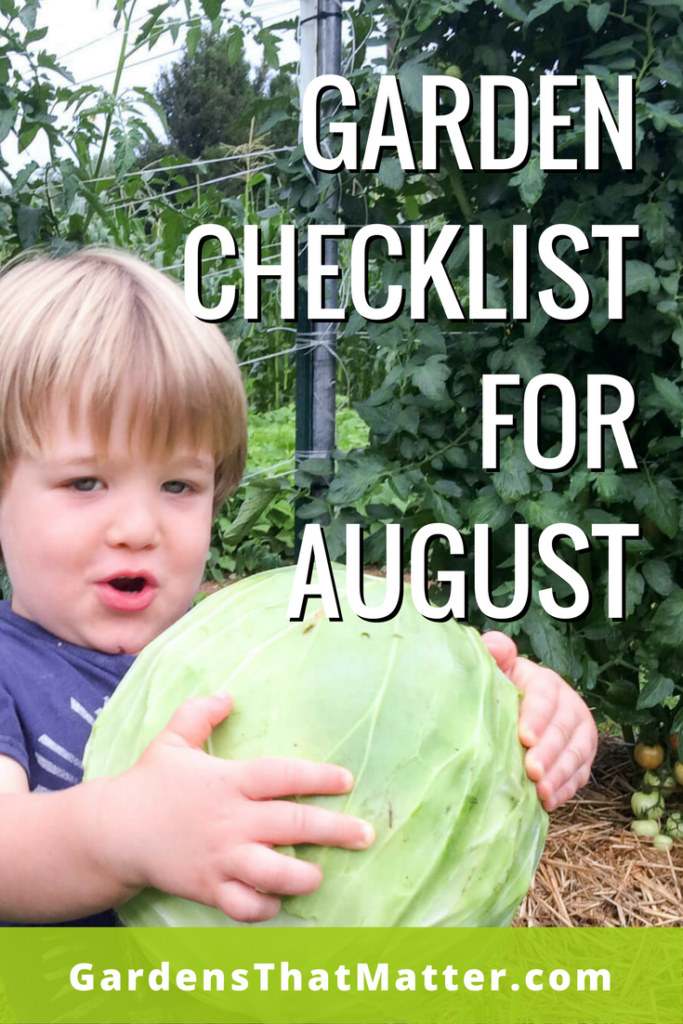
August Garden Checklist
Plants
- Challenge yourself to eat something from the garden every day.
It’s harvest season! When you pick ripe tomatoes, zucchini, cucumbers and okra, you send a signal to the plant to keep producing seeds. The plant strives to set seed, and you keep reaping the benefits. If you’re feeling overwhelmed by how to prepare the food, remember the flavors of your can’t-get-fresher produce can make even the simplest dish incredible. Here are Three Quick and Easy Tomato Dishes for Summertime (plus a few more from readers!).
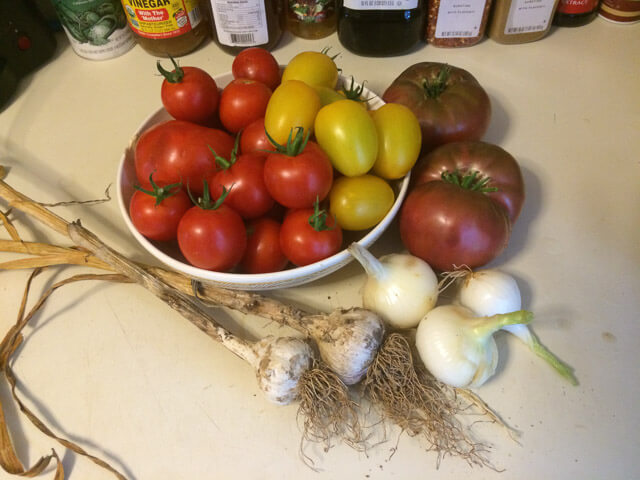
Tomato Soup: Before!
- Plant for fall.
If you’ve been disappointed in your summer growing season, it’s not too late to grow more food. If you had a good summer, keep up the momentum by planting for fall. Here are four ways a fall garden can give you a fresh start and more ideas for what you can plant. - Order flower and garlic bulbs.
Decide how much garlic you want, and if you’d like to add spring-blooming daffodils or tulips. Then, place your order. Most companies ship when it’s the right time to plant in your area. We got our garlic from a local garlic grower a couple years ago and save some of our biggest bulbs to plant the next fall. One of my favorite flower bulb retailers is Brent and Becky’s Bulbs. I had no idea so many varieties of bulbs even existed! - Protect the harvest.
Prop up branches heavy with fruit, cover fruit with netting to keep birds away, and set up a radio in the corn patch to scare off raccoons. - Tell squashes to STOP!
Pinch off the growing end of your pumpkins, gourds and winter squashes when you have enough fruit set. This discourages the vine from growing and directs the plant’s energy into ripening the fruits.
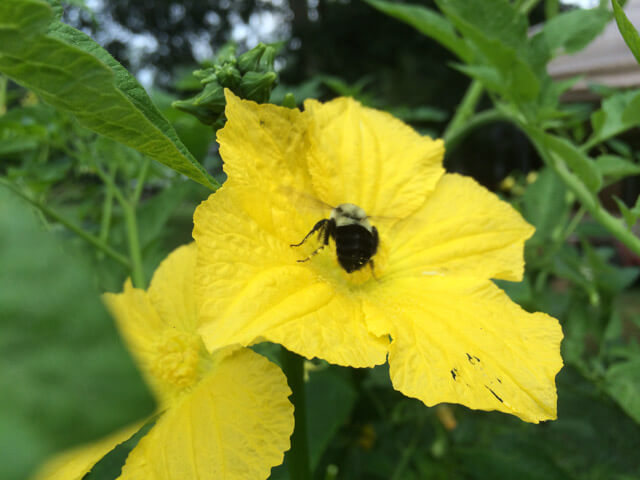
Encourage your squashes to stop producing new flowers by trimming the growing ends of the vine.
- Prune raspberries, blackberries and other caneberries after harvest.
Remove stems that have finished fruiting and any that look dead/diseased. You can do this work all the way into winter, but doing it now makes room for the new growth to fill in. - Get read to divide spring blooming perennials.
In most areas, early fall is a good times to divide iris, Echinacea, Coreopsis, daylily and others. Dig them up during an overcast day or the cooler morning/evening. Water well after planting, and consider adding a temporary screen or box to the west of the plant to give it a little shade as it gets re-established. - Enjoy the view!
Whether you have a few plants or many, take a moment to appreciate the work you and nature have done this summer. 🙂
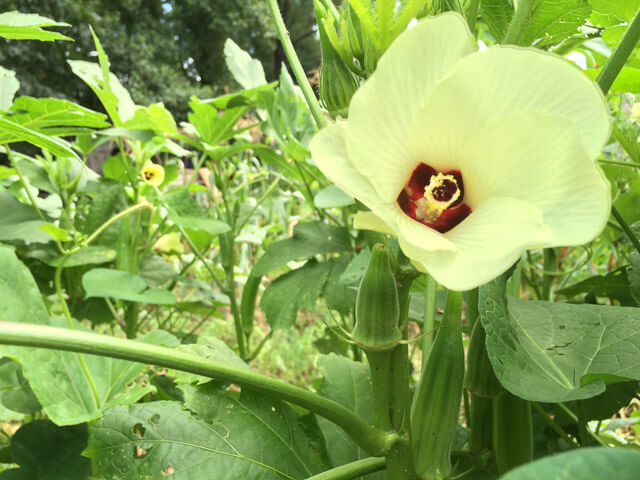
- Tend strawberries.
Clean up around your strawberry plants and add compost and mulch. Now’s a good time to pin down runners with a small rock or stick pressed into soil. You can direct their growth in the existing bed or put them into a pot so you can transplant later. We’ve noticed that our strawberries in beds with wood mulch thrive – runners root easily on their own. - Harvest herbs to dry.
Often at peak flavor just before they flower, herbs can be saved for year-round use by drying them in small bunches or on a screen out of direct sunlight. - Preserve the extra produce.
We find that blanching and freezing produce is the simplest and easiest way for us to preserve food now. We do have a few dozen canned green beans, and we’ll can a few dozen jars of tomatoes, tomato sauce, and salsa.
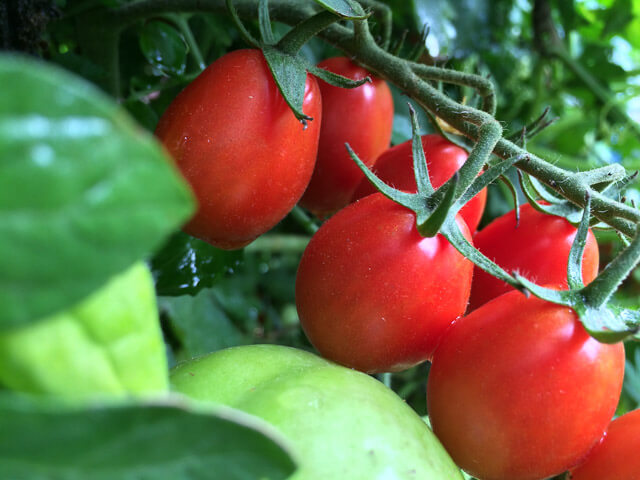
- Weed and mulch…
weed and mulch…weed and mulch…repeat! If you live in an area with rain this time of year, you see first-hand how weeds seem to appear and get huge overnight. If you’re feeling overwhelmed, focus on the aggressive and prickly ones first!
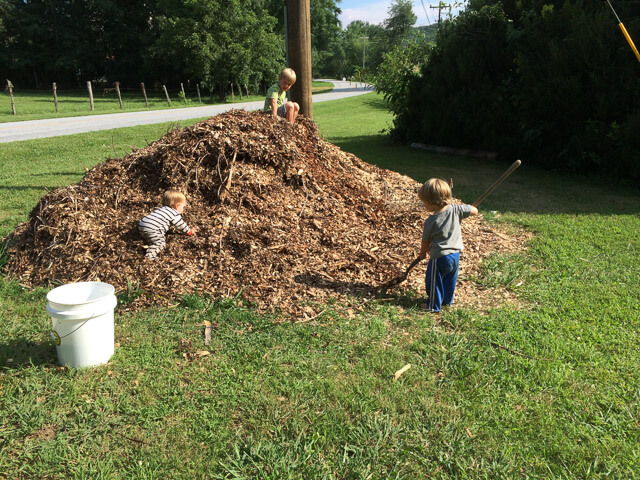
Soil
- Compost garden waste.
You can compost most plant waste, but be cautious with diseased and seedy waste. If you’re new to composting (or sometimes take a laid-back approach…like us :)), your pile may not get hot enough to kill pathogens and seeds. (Bury or burn the problem green waste instead.) - Plant something to feed your soil.
Use bare spaces to grow a cover crop for your soil. Or simply add a thick layer of manure or compost or leaves and leave it to rest until spring.
Wildlife
- Know thy enemy.
Pause when you see “bugs” in the garden and take a closer look. The first step in responsible and sustainable pest control is to identify the potential pest. Often, you can find a solution that uses the animal’s biology to your advantage (like collecting Japanese betles when they’re slow in the morning). Or you can find a solution targeted only at the pest you need help with (like using Bacillus thuringiensis kurstaki (Btk) to control cabbage moth caterpillars).
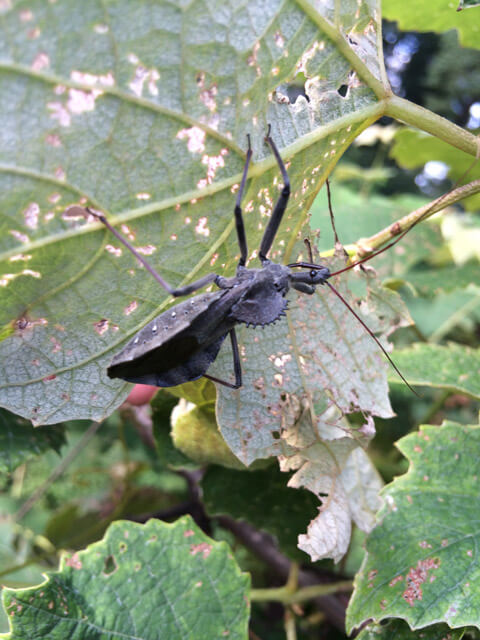
Friend or foe? Find out before you spray or kill insects. This wheel bug is a friend. It eats other insects that munch on leaves!
- Watch for caterpillars.
Enjoy watching them grow and change into chrysalids and adult butterflies.
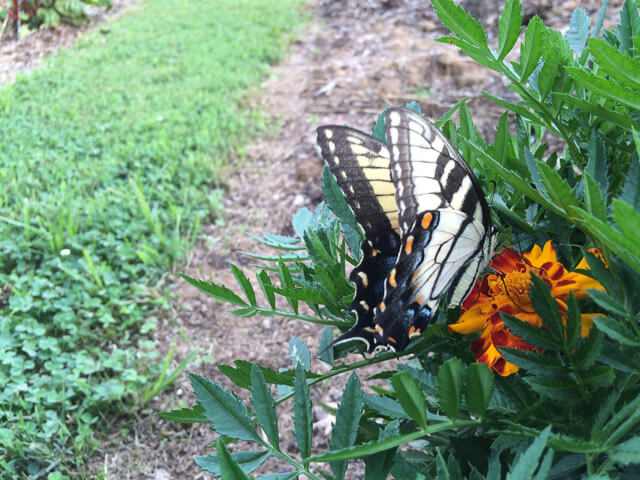
A swallowtail drinks from a marigold. Hopefully, it will laid eggs on a nearby sycamore tree or other host plant.
- Count butterflies.
Join the citizen science efforts to study monarchs as they grow and migrate. Learn more about monarchs and how you can help them at Journey North. - Stay on mosquito patrol.
The big trucks that spray for mosquitos are probably killing more beneficial insects than problematic ones. Instead, take care of mosquitos at the source – standing water. Either be vigilant about emptying it or create a trap…
Easy Mosquito Trap
Fill a 5-gallon bucket with water and a few handfuls of weeds/dried grass/straw. After a few days, the aroma of this water is irresistible to mosquito mamas looking for a nice place to lay eggs. Be sure to put your bucket where kids can’t get into it. Add a “crawling out stick” for any small accidental swimmers. Add a chunk of a mosquito dunk, which contains Bt (Bacillus thuringiensis), a bacterium that is toxic to the larva. Voila! Mosquito control without poison sprays. (Once a month, pour the stinky water into your compost pile or a hole at edge of yard. Refresh with new water, plant material and dunk.)
Kids
- Use your garden and yard to help with the back-to-school transition.
Playing outside after school is a great way to reconnect and decompress from “work” for kids and adults. Pediatric occupational therapist Angela Hanscom recommends at least three hours of free play outside for kids. (Read why here.) Be intentional about outdoor play, especially as you’re transitioning from summer fun to a busy school-year schedule. - Empower your kids to cook what they’ve grown in the garden.
Studies have shown that kids who help grow vegetables are more likely to eat them. Cooking adds to the fun! Our boys love to help us make pizza, salads, berry crumble, sweet potato pancakes, green smoothies, and more using foods grown right here at home. - Pick up garden-inspired books at the library.
Here are a few of our favorites for young kids:- Eating the Alphabet by Lois Ehlert – Bright, beautiful illustrations of common and unusual fruits and veggies from A to Z.
- The Very Hungry Caterpillar by Eric Carle – Our 4-year-old can “read” this one from memory…but he was STILL hungry!
- Zinnia’s Flower Garden by Monica Wellington – One section of our garden was inspired by Zinnia’s flower garden. We love how this book follows her from spring through winter with lots of fun details in the illustrations.
- Ladybug at Orchard Avenue by Kathleen Weidner Zoehfeld – This book is one of the fantastic series of Smithsonian’s Backyard Books. They tell detailed and biologically accurate stories of animals you might meet in the garden, yard, or forest. Ladybug is a favorite, but all of these books are in heavy rotation here!
- Sunflower Houses: Inspiration From the Garden–A Book for Children and Their Grown-Ups by Sharon Lovejoy – This one is more for me than the boys! I enjoy the playful illustrations and fun ideas for getting the kids involved in the garden.
- Visit a public garden.
Many botanic gardens and arboretums have special summer programs and events. Check out what’s happening in your community!
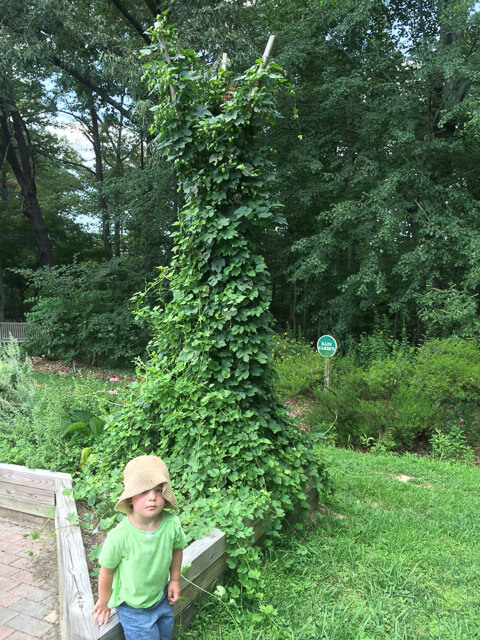
Check out these gorgeous hops at our Bullington Gardens down the road from us.
What’s on your list in the garden this month?
I’d love to hear about what projects you’re tackling and what tasks you’re checking off your list. Have you been eating from the garden? Sharing extras with your friends and neighbors? Tell me about it in the comments below!

Hi, Amy!
This is our second year on our new-to-us house and property … totaling 0.16 acres. Combining Back to Eden, lasagna, and square foot gardening. Found that a square foot of green beans or peas is NOT enough. I have been picking approx. 6 green beans every other day …. less of the peas. I did succession plant … just waiting for the other “little” patches to produce! We have been eating kale, swiss chard, lettuce and green onions …. so we are happy about that!! Picking a cherry tomato or 2 every day or so. Definitely a learning experience and looking forward to next year! We do have most of August left … and we have had lots of rain … our harvest may turn out better than we think!
This sounds like a great start! But yes, 6 green beans do not make a meal. 🙂
We grow our beans and corn in a bigger row garden here (a.k.a. “Grandpa’s Garden”) It works well since we often pick them all at once and can/freeze what we won’t eat that week. I do love the square-foot raised beds and in-ground wide beds for our greens, cucumbers, root crops, tomatoes, and herbs.
Here’s to an abundant rest of the month!